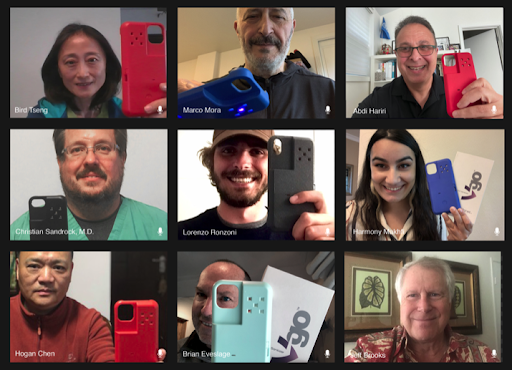Abdi Hariri M.S. ’84 and co-founder Marco Mora created V-Go, an iPhone-attachable product that aims to eliminate infectious droplets and particles on surfaces. Its parent company SaferPlanet states that V-Go is “the first ever proven, anti-pathogen Ultraviolet-C (UV-C) light integrated into your smartphone case.” UV-C light can be used to sanitize surfaces and inactivate bacteria.
The company partnered with Christian Sandrock, an infectious disease professor at the University of California, Davis, to test V-Go’s efficacy. Hariri said the device functioned with high efficacy during trials on aluminum, face masks, plastic, towels and glass.
The team found that the bacterial samples they set up — E. coli and staphylococcus — were inactivated within one to five seconds of exposure from V-Go’s one UV-A and four UV-C lights. As UV-C light is difficult for the naked eye to notice, the UV-A light functions alongside the UV-C lights to ensure that users see V-Go at work, Hariri said.
Though SaferPlanet has yet to test V-Go — priced at $129 — on the SARS-CoV-2 virus, they intend on doing so in the future. According to the U.S. Food and Drug Administration (FDA), UV-C light may be effective in inactivating the SARS-CoV-2 virus, as it previously inactivated similar coronaviruses. Currently, however, there is “limited published data about the wavelength, dose and duration of UV-C radiation required to inactivate the SARS-CoV-2 virus,” the FDA website reads.
With UV-C light having half the wavelength of visible light, Hariri and Mora believe this technology is effective in decontaminating air, water and surfaces — typical transmission paths that diseases take. Research has shown that UV-C is best suited to infiltrate DNA of bacteria and viruses because of spectral sensitivity, the ability of a certain wavelength to affect cells. When UV light is absorbed into cellular nuclei, it inactivates DNA and RNA, which eliminates bacteria’s ability to reproduce and cause future infections.
Thomas Jaramillo ’98, an associate chemical engineering professor not affiliated with V-Go, agreed, stating his belief in the promise of creating UV technologies for on-the-go sanitation but also stressing the importance of safety over novelty.
“As with any technology, care must be employed for safe operation,” he said. “For instance, not shining UV light into the eyes of others, either purposely or inadvertently. Engineering a product with safety in mind should come first.”
In response to incidences of UV light exposure accidents that are non-related to V-Go, Hariri said he and his team have spent hours evaluating solutions to prevent similar mishaps and to minimize danger for their users.
“According to some people, we have over-engineered the safety aspects of V-Go,” Hariri said, referring to its included safety features, such as a tilt sensor (which shuts off the device when tilted vertically), a required two-second hold to power up the case and a maximum 30 seconds of run time per usage. He emphasized that “V-Go should not be used on the skin or eyes.”
V-Go’s inception took place after multiple University of California, San Francisco hospital trips in 2019, where Hariri visited a fellow Stanford electrical engineering alum who battled an aggressive cancer. Through his visits, Hariri learned about Hospital Acquired Infections (HAI) — infections patients get while staying in medical centers for a separate healthcare reason.
According to Hariri, healthcare and semiconductors both face the common enemy of small contamination. He pointed to studies showing that mainstream applications such as disinfecting wipes do not work on all mutations and variations of pathogens and contribute to unintended cross-contamination, unlike UV-A and UV-C light.
With this background information, Hariri paired up with Mora to draft up several products designed to combat HAI effectively. However, when the pandemic hit in early 2020, Hariri and Mora decided to focus their time and effort primarily on V-Go.
Lucy Tompkins, a microbiology and immunology professor who is not affiliated with V-Go, credits her entire medical staff for maintaining rigorous methods to prevent HAI, especially during COVID-19, that have placed Stanford Medicine in the top 10% of academic medical centers nationwide by Vizient. Vizient is a leading organization that measures overall safety and quality in patient care.
Currently, Stanford-affiliated medical centers utilize a UV-C system called Xenex to frequently disinfect patient units, bathrooms and operating rooms, Tompkins said. Although there are many benefits of Xenex’s UV-C carts, she said that “the downsides are that it’s dangerous and nobody else can be in the room” when the system is in operation.
She sees “tremendous potential” for improved UV-C systems as time goes on. In the meantime, “various startup companies are looking at UV-C light to disinfect computers, keyboards and things that people touch all the time,” which Tompkins said could also be very beneficial.
V-Go’s founders have completed their nine-month prototype phase and are transitioning into production. According to Mora, he and Hariri have completed the engineering portion of the product themselves and have since coordinated with international partners in Italy and China to plan marketing and source material. In addition, they are seeking out students with marketing and computer science backgrounds to help them with upcoming projects.
As for building a user community, SaferPlanet hopes that V-Go is helpful to everybody, especially for those who frequent restaurants and events and travel for business.
“We are seeing a huge pool of interest from the medical community,” said Hariri, who also mentioned his goal of connecting with local hospitals in the area, especially Stanford-affiliated hospitals and medical centers.
Hariri also believes that in the future, people can begin to customize the UV lights on these types of products, allowing for different wavelengths to tackle a wider range of viruses and bacteria sanitation.
“I think we are only at the beginning of this journey to uncover the huge potential the technology offers to make our environment safer,” he said.
